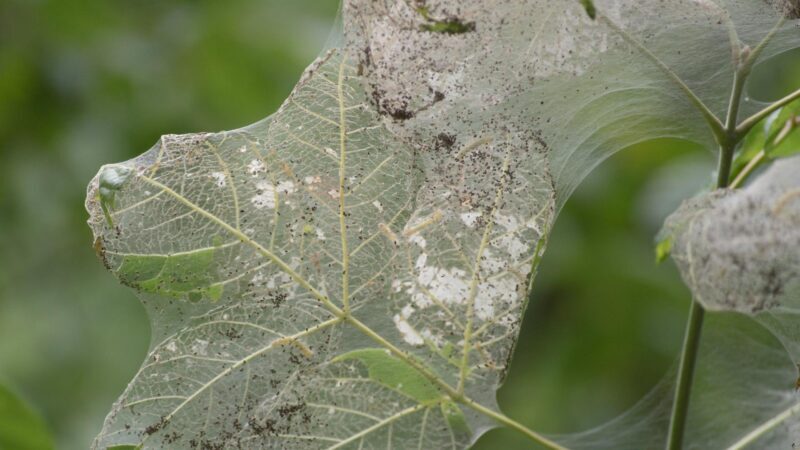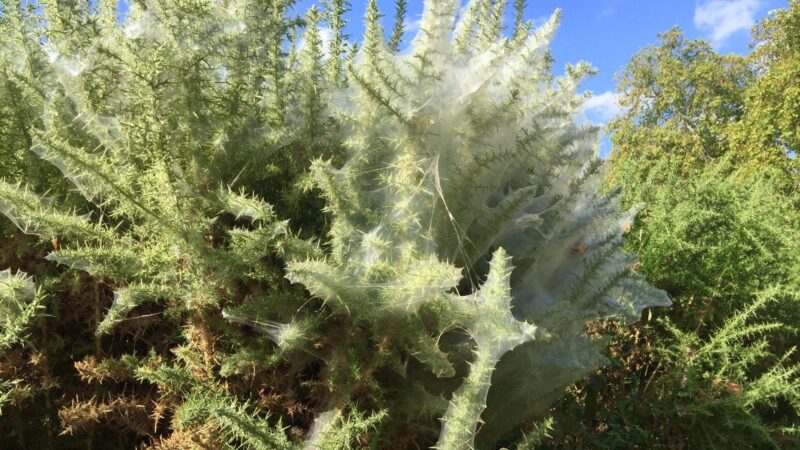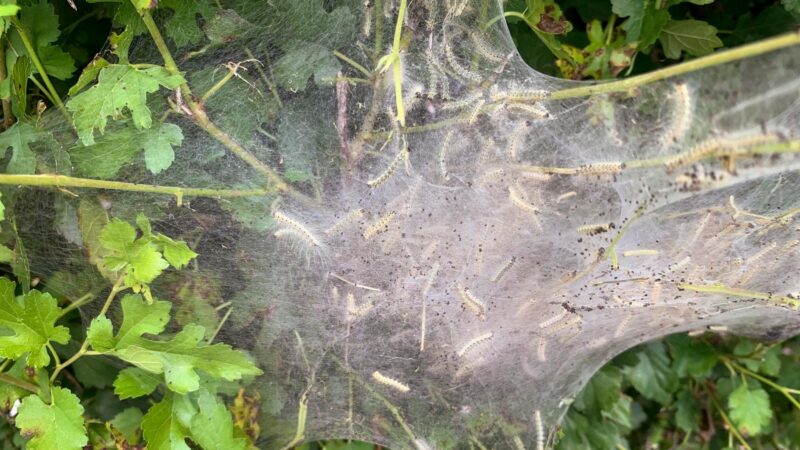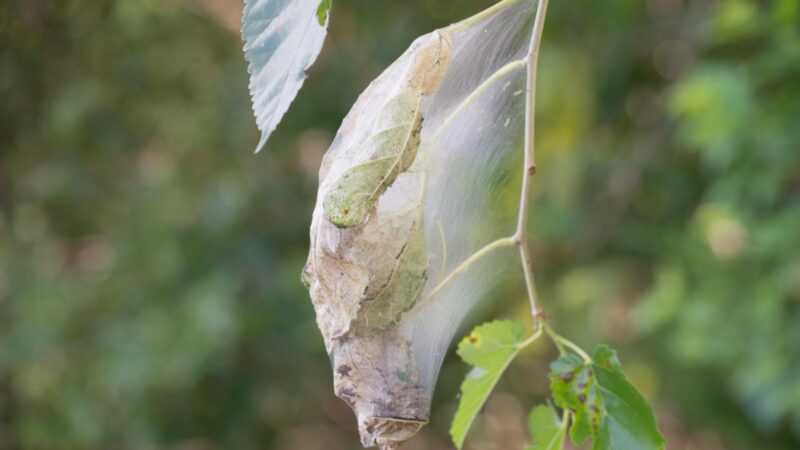If you spot a giant web in trees, it is not a spider web. To start with, spiders don’t make webs in trees but rather around plants.
The huge webs that you see in trees are made by certain moth species, including fall webworms. Before taking any action, you should understand these insects and their behavior first.
Why are there giant spider webs in my trees? Trees have giant spider webs because they are among the types of trees that fall webworms love to construct their nests at. Contrary to what some people might think, these huge webs are constructed by caterpillars of this moth species and not by garden spiders.
Fall webworms are very interesting insects since they can construct such big webs. Some gardeners consider these caterpillars as destructive pests, while others treat them only as nuisances and simply ignore them.
In case your trees have giant spider webs, this complete guide will help you decide what to do.
What Are the Large Web-Like Nests in Trees?

The large web-like nests in trees are not spider webs but rather are webs caused by fall webworms. These moths usually spin their fine silk webs over the end of branches of a wide variety of trees.
Because of their huge sizes, these nests look messy and are very eye-catching. These webs can be 3 feet wide or even bigger.
While fall webworms are feeding on the leaves, these huge web-like nests are white. The feeding may last for about 4-6 weeks. Once their feeding season is over, these caterpillars will leave the tree to become pupae.
At this point, their webs will turn brown or tan. Once these nests are empty, they will soon break.
Why Is My Tree Covered in Webs?

Your tree is covered in webs because of the fall webworms. Young stages of these larvae feed on the leaves while spinning their webs around them to protect themselves from predators.
As these caterpillars continue to grow and eat fresh leaves, they will cover them with webs until the entire set of leaves is covered.
What Do Fall Webworms Look Like?

Fall webworms are adults and larvae of Hyphantria cunea, a moth species that belong to the family Erebidae. Adult fall webworm moths have bright white, hairy bodies, while some have black spots.
They have a wingspan of about 35-42 mm. (1.37-1.65 inches). The bases of their front legs can be bright yellow or orange.
Young fall webworm larvae are usually pale yellow with two rows of black spots on their bodies. As they become mature, these caterpillars are about 1 inch long.
Their bodies are yellow or lime green with small black marks, as well black and white hair. These larvae undergo 5-7 instar stages before turning into pupae.
Interestingly, fall webworm larvae are often mistaken for Eastern tent caterpillars. Although these two insects look similar, Eastern tent caterpillars spin their webs near a tree trunk and not on the leaves.
Unlike fall webworms, they also appear only in the spring and are mostly found on crabapples and wild cherry trees.
Where Do Fall Webworms Come From?
Fall webworms originate in North America and are widely distributed around the globe, including Europe, Canada, and Asia, particularly China and Japan.
They were able to spread across different continents through human transport and trade. Today, these caterpillars continue to spread on various deciduous trees.
Are Fall Webworm Webs Dangerous for My Trees?

Fall webworm webs are not highly dangerous for your trees. These larvae may eat some leaves, but they cannot destroy the whole tree. Fall webworms rarely cause serious damage to trees.
They will leave them eventually once they are about to enter the pupal stage, which usually happens during winter.
Are Fall Webworms Bad?
Fall webworms are not necessarily bad but are somehow destructive. They feed on leaves, but they don’t kill the tree branches. In worst cases, their nest will cover all the branches or the entire tree.
Nevertheless, the only damage these caterpillars do is cosmetic, which means that the tree may look unappealing.
Do Fall Webworms Sting?
Fall webworms don’t sting humans. These caterpillars have no stinger, and they don’t bite, too. Both larvae and adult webworms also don’t carry infectious diseases, so it is safe to touch them.
But because they are very soft and they have tiny hairs on their bodies, you might want to wear protective gloves first.
Do Birds Eat Fall Webworms?
Most bird species eat fall webworms regularly just as they feed on other caterpillars. This includes chickadees, robins, sparrows, and vireos. But birds are not the only predators of webworms.
Among the other natural enemies of webworms are spiders, wasps, assassin bugs, and other small insect predators.
How Long Do Fall Webworms Last?

Female fall webworms start to appear between May and August to deposit their eggs, which are hatched within a week. Newly-hatch larvae will then start to skeletonize the leaves right away and will spin their webs.
Females lay eggs only once in their lifetime and die shortly, but fall webworms last for about six weeks.
Under normal conditions, the life cycle of fall webworms is completed in about 50 days. These caterpillars usually pupate during winter, but in most Northern states, there could be 2 to 3 generations per year.
But in general, fall webworms start to be active in late summer and are most active in the fall, hence the name.
Related: Zipper Spiders | An Unusual Threat to Your Home
What Trees Are the Most Vulnerable to Webworms?
Fall webworms have more than 90 tree species as potential sources of their food. Nevertheless, the trees that are most vulnerable to webworms are fruit and nut trees.
These moths prefer younger trees over the old ones or trees that are more than 5 years. Below are the trees that are the most vulnerable to webworms:
- Apple
- Ash
- Birch
- Cherry
- Crabapple
- Elm
- Hickory
- Linden
- Oak
- Pecan
- Persimmon
- Poplar
- Sourwood
- Sweetgum
- Sycamore
- Walnut
- Willow
What Are the Signs of a Fall Webworm Infestation?
Fall webworms don’t last long, which means that heavy infestations are very unlikely to happen. But if you are selling ornamental plants, these webworms will surely affect your productivity and income.
To avoid this scenario, you should know the different signs of a fall webworm infestation. Here are some of them:
1. Presence of Giant Spider Webs
Again, the nests of fall webworms look like giant spider webs. Each web may contain several hundreds of webworms. However, you may not see them clearly since they are inside the web.
Note that these nests are on the leaves. If the nests are near or on the trunk of the tree, they belong to Eastern tent caterpillars.
2. Presence of Fall Webworms Eggs
Females can lay between 400 and 1000 eggs in one sitting. These tiny, light-yellow to iridescent green eggs are laid in masses on the undersides of leaves.
Since they usually appear from late spring to summer, check thoroughly the bottom sides of the leaves of your trees, especially during these seasons.
3. Presence of Mature Fall Webworm Larvae
Mature fall webworm larvae can be seen leaving their nest as they prepare to become pupae. Some of them can be spotted in branches, far away from the nest.
Their movements are highly synchronized over a very wide area. They are mostly seen spinning a brown cocoon during the colder months in tree barks.
4. Presence of Adult Fall Webworms
Adult fall webworms are short-lived, but you can still see them flying around the trees. These moths are mostly white with some colored spots on their body and legs.
Although adults don’t cause direct harm to trees, they are responsible for the production of tons of eggs, which will shortly hatch into invasive larvae.
How Do You Get Rid of Giant Spider Webs in a Tree?
As mentioned earlier, giant spider webs in trees are only temporary and will not cause serious damage to healthy plants. In fact, the affected trees will continue to grow healthy despite some of their leaves being infested.
But if you cannot take the ugly sight, here is how you can get rid of fall webworm webs:
- For small trees, poke the giant spider web with a stick. This will force the fall webworms to leave their nest. Once they are exposed, their natural predators, such as birds and wasps will eat them.
- Instead of poking, you may pull the web using your hands. Although these caterpillars don’t bite or sting, you should still wear protective gloves.
- Dump the web in soapy water for a few hours until the webworms are dead.
- Alternatively, you may prune or cut the affected branch. Just make sure it will cause the tree to die.
- You can also aim your garden hose at these webs and give them a blast.
- If fall webworms are still young but in huge populations, you can use insecticides with pyrethrin, such as Bonide Pyrethrin Garden Insect Spray Mix .
- Pyrethrin Garden Insect Spray Concentrate from Bonide is a fast...
- Designed for use on asparagus, beans, broccoli, peppers, spinach,...
- The active ingredient, pyrethrin, naturally occurs in...
- Garden Insect Spray Concentrate can be used on vegetables up to...
- This product quickly mixes with water and should be applied using...
- For larger trees, you can simply ignore those webs. After all, the damage will be minimal and will not have a negative impact on them.
Note: Don’t burn the affected branches. This will cause more damage to your trees.
How Do You Get Rid of Moth Webs in Trees?
Aside from fall webworms, other moth species build nests on trees. This includes the Eastern and Western tent caterpillars, the Sonoran tent caterpillar, and the forest tent caterpillar.
Tent caterpillars also defoliate trees, but they only appear in the spring, and their nests are usually on large branches.
Therefore, the methods of getting rid of these moth webs are similar to that of fall webworm nests. Tent caterpillars also don’t bite or sting.
Therefore, you may poke their webs or remove them manually and soak their webs in soapy water. In severe cases, you can cut the affected branch or use a pyrethroid insecticide.
But just like fall webworms, tent caterpillars don’t live long and will be gone soon. They also rarely cause serious damage to trees and produce only one generation a year.
This means that they are easier to remove as compared to webworms. In most cases, the best thing to do is to simply let them enjoy life.
Summary
Fall webworms may cause damage to trees, but they are also food for birds and beneficial insects.
It is very uncommon to use pesticides against them or to call professional pest control. Instead of killing them, let nature decide their fate. Better yet, check your trees regularly to prevent webworms from infesting them.
List of Sources
Davenport, M. (2019). Fall Webworm Management. Clemson Cooperative Extension – Home & Garden Information Center.
Sourakov, A., Paris, T. (2021). Fall webworm. University of Florida.
Voyle, G. (2014). The rise and fall of the fall webworm. Michigan State University.
Fall Webworm on Trees. (2021). University of Maryland Extension.
- How to Get Rid of Turtles | Proven Long-Term Solutions! - August 26, 2023
- How to Get Rid of Kingsnakes | Easy & Humane! - August 26, 2023
- How to Get Rid of Northern Water Snakes | Best Solutions and Preventative Measures! - August 19, 2023

